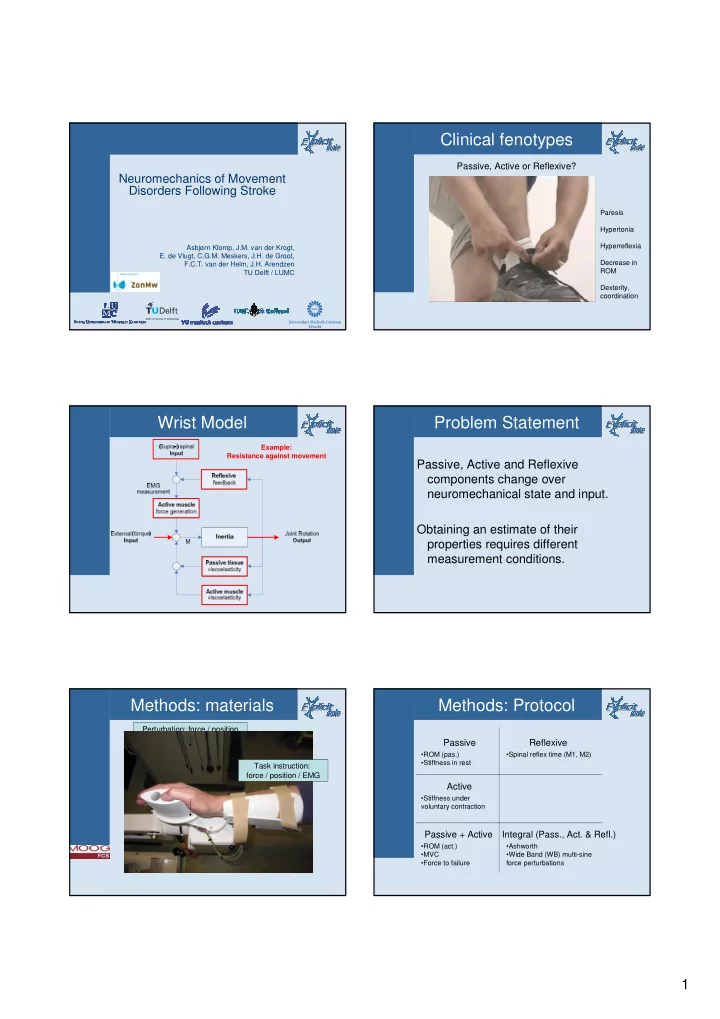

Clinical fenotypes Passive, Active or Reflexive? Neuromechanics of Movement Disorders Following Stroke Paresis Hypertonia Hyperreflexia Asbjørn Klomp, J.M. van der Krogt, E. de Vlugt, C.G.M. Meskers, J.H. de Groot, Decrease in F.C.T. van der Helm, J.H. Arendzen ROM TU Delft / LUMC Dexterity, coordination Wrist Model Problem Statement Example: Resistance against movement Passive, Active and Reflexive components change over neuromechanical state and input. Obtaining an estimate of their properties requires different measurement conditions. Methods: materials Methods: Protocol Perturbation: force / position Passive Reflexive •ROM (pas.) •Spinal reflex time (M1, M2) •Stiffness in rest Task instruction: force / position / EMG Active •Stiffness under voluntary contraction Force, position and EMG Neuromuscular modeling System identification Passive + Active Integral (Pass., Act. & Refl.) Neuronal & muscular parameters •ROM (act.) •Ashworth •MVC •Wide Band (WB) multi-sine •Force to failure force perturbations 1
Pilot Results Pilot Results Wide Bandwidth, multisine force Estimated Resist Relax Resist Reflexgain (kv) (+Damp) perturbations [Estimate of SEM] Healthy Patient Healthy Rep. 1 0.067 0.026 0.182 [0.037] [0.036] [0.081] Rep. 2 0.067 0.023 0.121 [0.076] [0.049] [0.041] Patient Rep. 1 0.101 0.026 0.105 [0.053] [0.066] [0.041] Rep. 2 0.137 0.024 0.094 Schouten, Meskers, 2009 de Vlugt 2006 [0.184] [0.052] [0.045] Green = Relax Dot = Healthy Red = ETFE Blue = Resist Red = Resist + damped environment Circle = Patient Blue = Model fit Pilot Results Conclusions • Ashworth (1sec./ROM & .5sec./ROM) We presented an approach for discrimination between passive Healthy Patient S tissue, active muscular and reflexive S E R G neuromechanical properties, in O R P different conditions. N I K R O W Future Work Sponsors • Improve understanding of clinical fenotype development from identified neuromuscular parameters • Use the parameters to improve treatment EXPLICIT website: www.explicit-stroke.nl • Nonlinear identification techniques E-mail: a.klomp@lumc.nl 2
EXPLICIT Protocol Supraspinal lesion Brain fMRI P. ROM Viscoelastic, P. Stiffness passive Corticospinal tract TMS MVC Neurological: Biomechanical: Muscle, A. Stiffness altered spinal reflex Peripheral reflex loop tendomuscular Haptic Robot active loop properties changes A. ROM Neuromechanics Neural Loop Passive sweep through the ROM in: Neural, - 1.0 Seconds Ashworth Kinematics/ Movement controller - 0.5 Seconds clinical scales WB Movement disorder Pilot Results Pilot Results • Stiffness in Rest • Force to Failure 3
Recommend
More recommend